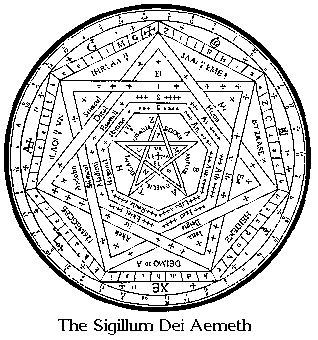
The Necronomicon is the title of a fictional text in the works of American fantasy/horror author H.P. Lovecraft and other writers in the Cthulhu Mythos genre of horror fiction.
The Necronomicon was first mentioned in Lovecraft's 1924 short story "The Hound", written in 1922, though its purported author, the "Mad Arab" Abdul Alhazred, had been quoted a year earlier in Lovecraft's "The Nameless City". Inter alia, the work contains an account of the Old Ones, their history, and the means for summoning them.
Capitalizing on the notoriety of the fictional volume, real-life publishers have printed many books entitled Necronomicon since Lovecraft's death, many of which contain material of dubious value.
How Lovecraft conceived the name "Necronomicon" is not clear�Lovecraft himself claimed that the title came to him in a dream. Although some have suggested that Lovecraft was influenced primarily by Robert W. Chambers' collection of short stories The King in Yellow, which centers on a mysterious and disturbing play in book form, Lovecraft is not believed to have read that work until 1927.
Donald R. Burleson has argued that the idea for the book was derived from Nathaniel Hawthorne, though Lovecraft himself noted that "mouldy hidden manuscripts" were one of the stock features of Gothic literature.

Lovecraft wrote that the title, as translated from the Greek language, meant "An image of the law of the dead": nekros ("corpse"), nomos ("law"), eikon ("image"). A more prosaic (but probably more correct) translation can be derived by conjugating nemo ("to consider"): "Concerning the dead".
In 1927, Lovecraft wrote a brief pseudo-history of the Necronomicon that was published in 1938, after his death, as A History of The Necronomicon. According to this account, the book was originally called Al Azif, a word that Lovecraft claimed was an Arabic word that referred to "that nocturnal sound (made by insects) supposed to be the howling of daemons".
In the History, Alhazred is said to have been a "half-crazed Muslim" who worshipped the Lovecraftian entities Yog-Sothoth and Cthulhu. He is described as being from Sanaa in Yemen, and as visiting the ruins of Babylon, the "subterranean secrets" of Memphis and the Empty Quarter of Arabia (where he discovered the "nameless city" below Irem). In his last years, he lived in Damascus, where he wrote Al Azif before his sudden and mysterious death in 738.

In subsequent years, Lovecraft wrote, the Azif "gained considerable, though surreptitious circulation amongst the philosophers of the age." In 950, it was translated into Greek and given the title Necronomicon by Theodorus Philetas, a fictional scholar from Constantinople. This version "impelled certain experimenters to terrible attempts" before being "suppressed and burnt" in 1050 by Patriarch Michael (a historical figure who died in 1059).
After this attempted suppression, the work was "only heard of furtively" until it was translated from Greek into Latin by Olaus Wormius. (Lovecraft gives the date of this edition as 1228, though the real-life Danish scholar Olaus Wormius lived from 1588 to 1624.) Both the Latin and Greek text, the History relates, were banned by Pope Gregory IX in 1232, though Latin editions were apparently published in 15th century Germany and 17th century Spain. A Greek edition was printed in Italy in the first half of the 16th century.
The Elizabethan magician John Dee (1527-c. 1609) allegedly translated the book�presumably into English�but Lovecraft wrote that this version was never printed and only fragments survive. (The connection between Dee and the Necronomicon was suggested by Lovecraft's friend Frank Belknap Long).
According to Lovecraft, the Arabic version of Al Azif had already disappeared by the time the Greek version was banned in 1050, though he cites "a vague account of a secret copy appearing in San Francisco during the current century" that "later perished in fire". The Greek version, he writes, has not been reported "since the burning of a certain Salem man's library in 1692"--an apparent reference to the Salem witch trials. (Nonetheless, Alonzo Typer finds a Greek copy in The Diary of Alonzo Typer.)
The Necronomicon is mentioned in a number of Lovecraft's short stories and in his novellas At the Mountains of Madness and The Case of Charles Dexter Ward. However, despite frequent references to the book Lovecraft was very sparing of details about its appearance and contents. He once wrote that "if anyone were to try to write the Necronomicon, it would disappoint all those who have shuddered at cryptic references to it."

In "The Nameless City" (1921), a rhyming couplet that appears at two points in the story is ascribed to Abdul Alhazred. The same couplet appears in "The Call of Cthulhu" (1928), where it is identified as a quotation from the Necronomicon. This "much-discussed" couplet, as Lovecraft calls it in the latter story, has also been quoted in works by other authors, including Brian Lumley's The Burrowers Beneath which adds a long paragraph preceding the couplet.
The Necronomicon is undoubtedly a substantial text, as indicated by its description in The Dunwich Horror (1929). In the story, Wilbur Whateley visits Miskatonic University's library to consult the "unabridged" version of the Necronomicon for a spell that would have appeared on the 751st page of his own inherited, but defective, Dee edition.
The Necronomicon's appearance and physical dimensions are a mystery. Other than the obvious black letter editions, it is commonly portrayed as bound in leather of various types and having metal clasps. Moreover, editions are sometimes disguised. In The Case of Charles Dexter Ward, for example, John Merrit pulls down a book labelled Qanoon-e-Islam from Joseph Curwen�s bookshelf and discovers to his disquiet that it is actually the Necronomicon.
In the works of Brian Lumley, the occult investigator Titus Crow possesses a copy that is allegedly covered in sweaty human skin.




